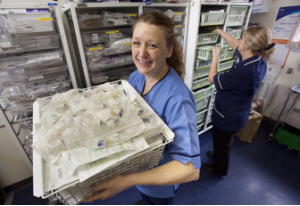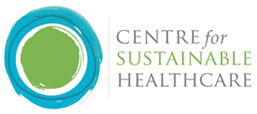- Group home
- You must register/login in order to post into this group.
Bolus Administration of Intravenous Antibiotics

By: NHS Fife
In addition to the cost and carbon savings, benefits were gained by reducing the volume of fluid administered in the context of renal failure, more efficient use of nursing time and increased nurse-patient contact and IV cannula observation. Also time was not wasted locating infusion pump devices and the ward was quieter without bleeping pumps.
£17,060 (Estimated)
6.73 tonnes CO2e (Estimated)
Queen Margaret Hospital (QMH) has 24 in-patient beds, 20 dialysis stations and serves a population of 350,000. Prior to the end of 2010 all intravenous (IV) antibiotics were given by infusion even where bolus could be safely used. This used a great deal of plastic. Additionally semi-prepared ‘mini-bags’ (designed for use in the community) were being used for convenience which was unnecessary.
To determine if savings were possible a retrospective analysis of antibiotic use, cost and carbon emissions was performed based on pharmacy records over a one-year period (October 2009–September 2010). Savings were then calculated assuming a similar pattern of antibiotic use, price and nursing staff time, but assuming infusion is replaced by bolus administration. 13 antibiotics were identified as suitable for bolus administration after pharmacy review. Antibiotics requiring infusion were excluded from the analysis leaving a total of 6,175 doses infused. The financial and carbon saving (below) were large and steps were taken to change practice. Staff were educated to deliver drugs safely by bolus and a suitable preparation area was identified. Practice was changed from the beginning of 2011 with audit planned. This has been easily adopted by staff and there have been no safety concerns to date but maintining practice has been challenging.
Background
The NHS has an increasing chronic care burden and must conform to the NHS carbon reduction strategy in a time of relative funding reduction. Procurement forms a significant component of the NHS budget and 60% of the NHS carbon footprint. This rises to 72% for renal services where equipment and pharmaceutical use is high. Reducing procurement emissions is a ‘quick win’ and systematic analysis of clinical processes can identify non-essential consumables and provide opportunities to lean treatment pathways that will deliver both cost and carbon savings.
Financial Considerations
This project incurred no additional cost to the NHS being funded entirely by staff enthusiasm where extra work was required. All training could be provided ‘in-house’.
Excluding drug costs, infusion via an infusion pump cost £1.96 per administration (pump administration set, £1.38; 50-100mls sodium chloride or dextrose bag, £0.35; 20ml syringe, £0.09; 21G needle x2, £0.04; Alcowipes x2, £0.01) verses £0.22 for bolus administration (10ml syringe, £0.12; 10ml sodium chloride, £0.045; 21G needle x2, £0.04; Alcowipes x2, £0.01). The total cost, including ‘mini-bags’ was £11,158. Assuming identical antibiotic use the predicted annual cost saving was £9,830 (88.1%). Savings from reduced disposal (0.41 tonnes equipment waste saved) by incineration are estimated at £165 annually (assuming a cost of £400 per tonne) bringing the total saving to £9,995 per year. In addition to consumables, further annual drug cost savings of £7065.33 were made by purchasing vials for bolus administration rather than pre-prepared mini-bags for infusion bringing the overall total saving to £17,060 annually.
Carbon Savings
Supply chain emissions saved (manufacture, transport etc):
- Equipment: £9830 x 0.30 kg CO2e / £ * = 2949 kg CO2e
- Drug: £7065 x 0.43 kg CO2e / £ * = 3038 kg CO2e
Emissions saved from avoided incineration of plastic waste:
- 0.406 tonnes plastic x 1833 kg CO2e / tonne ** = 744 kg CO2e
Total emissions saved, per year:
- 2949 + 3038 + 744 = 10,020 kg CO2e, or 6.73 tonnes CO2e
* Greenhouse gas (GHG) conversion factors for supply chain were obtained from the 2012 Guidelines to Defra / DECC's GHG Conversion Factors for Company Reporting (Annex 13).
** Greenhouse gas (GHG) conversion factors for waste incineration were obtained from the 2011 Guidelines to Defra / DECC's GHG Conversion Factors for Company Reporting (Table 9d).
GETTING STARTED – ‘HOW TO’ GUIDE
- Ascertain current practice by auditing antibiotic use and administration methods on the ward – are you missing opportunities to reduce infusions?
- Involve senior nursing, medical and pharmacy staff early on.
- Patient safety is the first priority – confirm drugs which can safely be given by bolus and how this is done. Set out clear procudures that can be easily accessed in the preperation area.
- Identify an areas for bolus preparation if not already in existence.
- Listen to staff concerns and address these through education and training as needed.
- Ensure adequate numbers of trained staff are on the ward so that drugs can be administered as boluses on every shift.
- Set a start date which everyone is aware of.
- Measure the outcome by audit and staff feedback.
Further tips
Savings could be amplified if IV bolus administration was adopted as standard practice across NHS specialties and for all IV drugs suitable for this route of administration.
Queen Margaret Hospital, Whitefield Road, Dunfermline, Fife, KY12 0SU
The lead nurse for this project has since been asked by the Trust to extend the initiative to the Emergency Care Directorate (ECD). Her initial investigations show that in the ECD in 2011, 57,412 doses of IV antibiotics which could have been bolused were delivered by IVI, at a cost of £149,462. To change to bolus will save £138,554.
